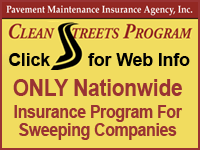Best Practices |
When It Comes to Insurance Coverage for Your Company Operations, Consider Separating Good From BadAlthough snow removal is the example used in this article, the information is the same for separating coverages on any of your different business types where one or more of them, for whatever reason, typically experiences a higher claims' liability.by Scott Cerosky 
 It is common for sweeping contractors who are located in snow-belt states to supplement their income during the winter months by performing snow removal operations. Because of the nature of the work, it typically presents the business with increased liability exposures that can be both costly and of a different sort from those seen with sweeping.
It is common for sweeping contractors who are located in snow-belt states to supplement their income during the winter months by performing snow removal operations. Because of the nature of the work, it typically presents the business with increased liability exposures that can be both costly and of a different sort from those seen with sweeping.
This article points out some of the more common risks involved with snow removal operations and how these relate to your insurance costs. It also offers suggestions about what can be done, on an insurance level, in this vital area of your business operations in order to improve your bottom line. From an insurance perspective, there is traditionally more claims activity related to snow removal operations than there is for sweeping operations; specifically, there is increased risk of slip-and-fall incidents. The risk potential in snow plowing is magnified, in most cases, by the scope of the language the property owner requires the contractor to sign. This language usually includes specific hold harmless and indemnification clauses that insulate the property owner from claims resulting from snow removal operations. Unfortunately for the contractor, if these agreements are not signed with this detrimental language inserted, they will probably not be rewarded the contract. Most of the time, snow plowing claims fall under your General Liability policy and if present, your Umbrella Liability policy. Other escalated claims activity can be related to your Automobile policy. This is usually a result of snow removal being performed during the storms themselves and over long stretches of time, which creates operator fatigue and maximizes risk. How does this level of risk compare to sweeping operations? Snow and ice usually covers the majority of roadways, parking lots and sidewalks until removed. By contrast, sweeping debris is usually confined to the corners and edges of paved areas, which significantly reduces the risk for slip-and-fall of pedestrians. In addition, parking area sweeping operations are done at night with virtually no other moving traffic. It goes without saying that if the majority of snow plowing is performed on properties where there is greater pedestrian traffic (i.e., shopping centers, office parks, schools, etc.) then the risk for increased claims activity increases. Mind you that all of this takes into consideration that you are doing the best job possible with internal risk management procedures for your operations. The contrast of these two exposure types is what creates the difference in claims activity. What you do not want is the higher exposure of your snow removal operations to negatively impact your lower exposure, and typically most profitable, sweeping operations. Here's why, as well as what actions you may want to take to minimize the potential for this happening. In general, insurance premiums are based on a rating system that takes into account prior claims history. Since each segment of work you perform develops its own claims rate, it makes sense to take steps to have the most profitable segment of your business enjoy the lowest rates available. Therefore, if this type of situation exists in your business, you should consider establishing separate and distinct entities for each operation. Then, insure each of them with separate policies. Doing this will isolate the higher risk operations from the lower risk operations, resulting in overall premium savings. It may take some time for the impact of the old snow removal claims to disappear from the sweeping operations, but in time they will. The rule of thumb for insurance rating is that policies are based on rating over a four-to-five year review of loss history. After that timeframe is reached, most typical contractors will experience an overall premium drop as compared to their previouspolicy costs on their combined operations. However, if the amount of your snow removal operations are incidental to your sweeping operations, this process may not be worth the trouble. That's because the risk would not be that detrimental to your sweeping operations and overall insurance costs. The rule of thumb for this decision is it's probably not to your advantage to separate your businesses if snow removal, on average, is less than ten percent of your annual combined gross receipts. 
Do not be afraid to engage your insurance representative in this dialogue. They are there to look out for your best interests, so put them to work. There are insurance companies countrywide that do offer general liability and auto coverage specifically for snow removal operations. You have nothing to lose and everything to gain by investigating this procedure. I hope this advice finds its way into reducing your claims activity and overall insurance costs. Happy and Safe Sweeping! Scott Cerosky is president of Pavement Maintenance Insurance Agency. Their organization is a leader in providing insurance packages tailored to the street and parking area sweeping industry. For more information on the company, its Clean Streets program and the coverages it provides, call 800-656-3919. You may also reach Scott via email sent to scott@cleanstreetsins.com. |
© 2005 - 2012
|
Parking Area Sweeping Contents
|